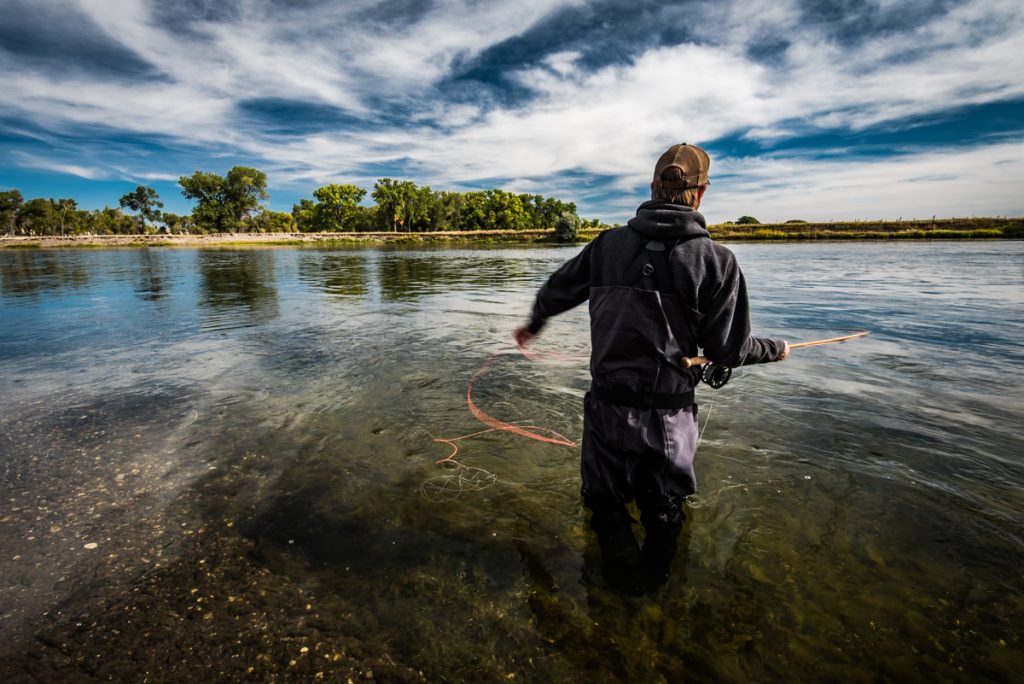The two-handed crowd is beginning to show up for the fall streamer experience. Last year I stated it was a bit early. I still think that, with the opportunity to present dry flies to 20-inchers on a daily basis, but this fall is shaping up a little different than last year. The weathers a little nastier. The weed and algae hangup is almost non-existent. Water temperatures are cooler. And most importantly, the trout are grabby.
This week is bringing some excellent streamer fishing weather to most of Montana, and the Missouri River is no exception. Yesterday was wet, cold and windy, and this morning folks can see snow on the high peaks if you can see them through the clouds. Cooler temps and a chance of precipitation are forecast through the week. Game on for streamer and dry fly anglers.
If hitting the river with a two-handed rig is on your agenda, here’s a few tips:
KEEP THAT TIP LIGHT
This time of year you’ll find a Scandi head on my rod in 95% of the runs I’d be fishing. No need to get real deep in most spots, and I like to cover lots of water in the early fall (our trout are moving around a lot right now). If you’re using a Skagit head use an intermediate tip like the iMOW. Most troutspey (2-4 weight) anglers will be using one of the super short Skagit heads like the OPST Commando or the new Airflow Scout. If you are looking for an excellent line for a faster Scandi style cast on your micro-spey, the Scientific Angler Adapt is an excellent choice. It is an integrated line, and one of the few I really like in the sub-300 grain region.
There are a few spots where you’ll want to fish deeper. Below Holter is one. Lots of deep and quick water, and there might be a few large migratory Browns that have moved in there. Here I’d be using a Skagit system with a 10-12 foot T-8 or T-11 tip and a big nasty streamer. Egg sucking might be a wise choice.
KEEP YOUR LEADER AND TIPPET LONG
I see many anglers who are trying to use techniques adapted from Steelhead fishing. In particular, the strange obsession with seeing how short and heavy a leader can actually be. Think 12″ of straight 20lb on the end of a Skagit tip. Like many, I’ve done this successfully on BC Steelhead rivers, but the Missouri River is not full of wild anadromous Steelhead. And it’s clear. It’s full of old resident Brown trout who are very aware of their surroundings and what food is supposed to look like. I always try and keep a Skagit leader around 5-6 feet long. Typical tippet would be 0x-2x flouro. Scandi and long belly lines should have a leader the length of the rod attached.
BE PREPARED TO FISH LONG AND SHALLOW
If you fish the Missouri often during the fall, you’re probably aware that it is common to find Brown trout lying in very shallow water. This is especially true during stormy weather (like this week) and early and late in the day. I like to cover large flats, often ranging in depth form 1 to 3 feet. This is no place for a tip, so stick to a floating line/head. If you do use a sink tip, you’ll be cleaning lots of weeds off the flat for me, which I appreciate.
But a floating line is not the only important piece of the puzzle. You also need to land you line and fly gently. A line or head with a longish front taper helps achieve this. Standard Compact Scandi heads in the 30-35 foot length are usually perfect. Mid belly lines present very quietly, but can lack the power to turn over large flies. Remember to stop the rod tip high just like your dry fly cast. If you drive that tip down, you’ll roll that fat spey head into the river and probably be able to count on two hands the wakes of big trout scattering.
SKITTER A CADDIS?
This is really the only time of the year that skating a dry fly can work with any consistency for us. Caddis hatches are not massive this time of year, but there are a few around including the giant October Caddis. Our trout have recently been feeding on hoppers and flying ants, so surface bugs with motion are on their brains. For the October Caddis I’d be using a 5-6 weight two-hander, but if you’re trying to imitate the smaller brown caddis you’ll need to drop down to a 2-3 weight to match the lighter tippet you’ll be using. The violent take also requires a very light and limber rod to absorb the shock. The smaller ECHO glass rods are perfect, and the new Sage Pulse 3110 is a very limber rod as well.
FLIES
Most people I talk to are going to use the biggest and nasties fly in their box this time of year. I get it. But realistically you are probably going to do better with a smaller Clouser, Kreelex or small heavy bugger. Just saying’. Large home-brew soft hackles that imitate October Caddis can also work pretty well.
It’s starting to get pretty cool on some of the Freestones, but an afternoon spent on rivers like the Big Hole or Blackfoot could produce some very big fish and are definitely worth a try. These rivers are low right now, allowing you to cover them bank to bank.
Good luck out there if you’re giving it a go, and stop by the shop if you have any questions about spey lines, lightweight “troutspey” rods, leaders, flies, rigid, shooting lines, reel, etc.

